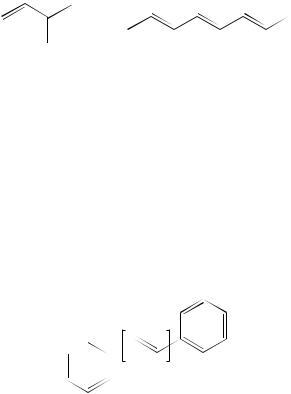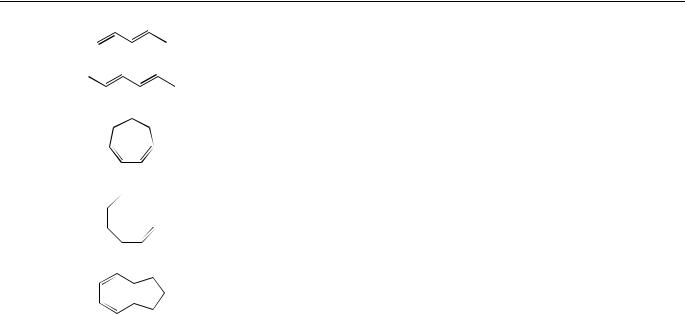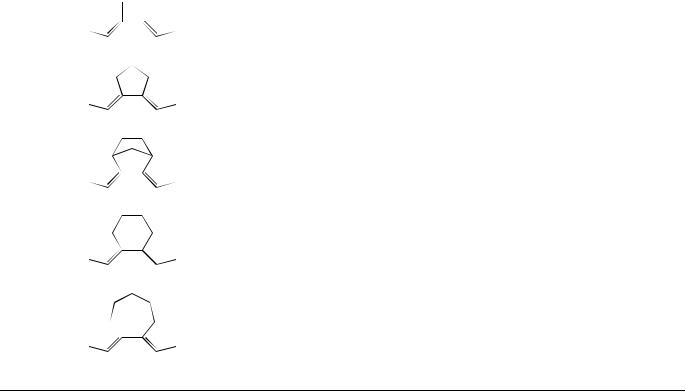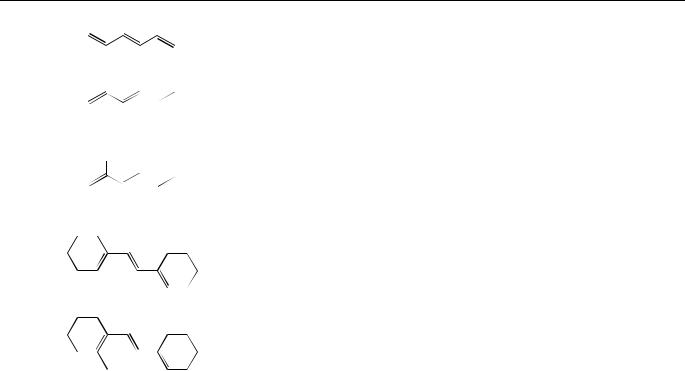

The Chemistry of Dienes and Polyenes. Volume 2
Edited by Zvi Rappoport
Copyright 2000 John Wiley & Sons, Ltd.
ISBN: 0-471-72054-2
CHAPTER 3 |
|
|
Photopericyclic reactions of |
|
|
conjugated dienes and trienes |
|
|
BRUCE H. O. COOK and WILLIAM J. LEIGH |
|
|
Department of Chemistry, McMaster University, 1280 Main St. W., Hamilton, |
|
|
Ontario, Canada, L8S 4M1 |
|
|
Fax: (905)522-2509 email: leigh@mcmaster.ca |
|
|
I. INTRODUCTION . . . . . . . . . . . . . . . . . . . . . . . . . . . . . . . . . . . . . . |
198 |
|
II. GROUND STATE CONFORMATIONAL EQUILIBRIA AND |
|
|
E,Z-ISOMERIZATION . . . . . . . . . . . . . . . . . . . . . . . . . . . . . . . . . . |
199 |
|
III. THE EXCITED SINGLET STATES OF CONJUGATED POLYENES: UV |
|
|
ABSORPTION AND EMISSION SPECTRA . . . . . . . . . . . . . . . . . . . . |
200 |
|
IV. SINGLET STATE PHOTOCHEMISTRY OF CONJUGATED DIENES AND |
|
|
TRIENES . . . . . . . . . . . . . . . . . . . . . . . . . . . . . . . . . . . . . . . . . . . |
202 |
|
A. Direct E,Z-Isomerization . . . . . . . . . . . . . . . . . . . . . . . . . . . . . . . |
203 |
|
B. cis,trans-Conformational Interconversion . . . . . . . . . . . . . . . . . . . . . |
211 |
|
C. Photopericyclic Reactions of Conjugated Dienes . . . . . . . . . . . . . . . . |
212 |
|
1. |
Cyclic and acyclic conjugated dienes . . . . . . . . . . . . . . . . . . . . . |
212 |
|
a. Cyclobutene formation . . . . . . . . . . . . . . . . . . . . . . . . . . . . . |
212 |
|
b. Bicyclo[1.1.0]butane formation . . . . . . . . . . . . . . . . . . . . . . . |
221 |
|
c. [1,5]-Hydrogen migration . . . . . . . . . . . . . . . . . . . . . . . . . . . |
224 |
2. |
Electrocyclic ring opening of 1,3-cyclohexadienes . . . . . . . . . . . . . |
225 |
|
a. Experimental studies . . . . . . . . . . . . . . . . . . . . . . . . . . . . . . |
225 |
|
b. Theoretical and time-resolved spectroscopic studies . . . . . . . . . . |
230 |
D. Photopericyclic Reactions of Conjugated Trienes . . . . . . . . . . . . . . . . |
231 |
|
1. |
The photochemistry of Z-1,3,5-hexatriene . . . . . . . . . . . . . . . . . . |
231 |
2. |
The NEER Principle . . . . . . . . . . . . . . . . . . . . . . . . . . . . . . . . |
232 |
3. |
Formation of bicyclo[3.1.0]hex-2-enes: the ‘photochemical Diels–Alder |
|
|
reaction’ . . . . . . . . . . . . . . . . . . . . . . . . . . . . . . . . . . . . . . . . |
235 |
4. |
The photochemistry of vitamin D and its isomers . . . . . . . . . . . . . |
239 |
5. |
Theoretical and time-resolved spectroscopic studies of triene |
|
|
photochemistry . . . . . . . . . . . . . . . . . . . . . . . . . . . . . . . . . . . . |
241 |
6. |
Benzannelated dienes and trienes . . . . . . . . . . . . . . . . . . . . . . . . |
243 |
The chemistry of dienes and polyenes, Vol. 2 |
|
|
Edited by Z. Rappoport 2000 John Wiley & Sons Ltd |
|
|
197

198 |
Bruce H. O. Cook and William J. Leigh |
|
7. |
Photochromic materials based on cyclohexadiene/hexatriene |
|
|
interconversions . . . . . . . . . . . . . . . . . . . . . . . . . . . . . . . . . . . |
244 |
8. |
Cyclic trienes . . . . . . . . . . . . . . . . . . . . . . . . . . . . . . . . . . . . . |
247 |
V. CONCLUSION . . . . . . . . . . . . . . . . . . . . . . . . . . . . . . . . . . . . . . . . |
249 |
|
VI. REFERENCES . . . . . . . . . . . . . . . . . . . . . . . . . . . . . . . . . . . . . . . . |
249 |
|
I. INTRODUCTION
The photochemistry of conjugated polyenes has played a central role in the development of modern molecular photochemistry, due in no small part to its ultimate relevance to the electronic excited state properties of vitamins A and D and the visual pigments, as well as to pericyclic reaction theory. The field is enormous, tremendously diverse, and still very active from both experimental and theoretical perspectives. It is also remarkably complex, primarily because the absorption spectra and excited state behavior of polyene systems are strongly dependent on conformation about the formal single bonds in the polyene chain, which has the main effect of turning on or off various pericyclic reactions whose efficiencies are most strongly affected by conformational factors.
The present review focuses on the excited singlet state photochemistry of non-phenyla- ted conjugated dienes and trienes, emphasizing pericyclic reactions. Conjugated tetraenes and arylated polyenes will receive only brief, occasional mention, in spite of their obvious relevance and the huge amount of work that has been done on their photochemistry and photophysics. Triplet state photochemistry has also been omitted. This approach has been taken in order to provide a practical limit to the already overwhelming amount of literature which needs to be covered, and for ‘chemical’ reasons as well. Arylated polyenes tend to exhibit the same high reactivity toward photoinduced E,Z-isomerization as their non-arylated counterparts, but behave differently in most other respects: they fluoresce efficiently in fluid solution at room temperature and, in general, do not display the same rich reactivity toward pericyclic photoprocesses as non-arylated systems. The reader is directed to several excellent reviews1 –5 and particularly recent articles6 –10 on aryl-polyene photochemistry and polyene triplet state photochemistry for further information on these topics. The photochemistry of octatetraene has also been reviewed in detail recently11.
Theoretical treatments of organic photochemical reactions have evolved enormously over the past ten years. Polyene photochemistry has been at the very center of this revolution, which would appear to be taking us away from the classic model of van der Lugt–Oosterhoff, who first detailed the critical role of the doubly-excited 21Ag state in directing the ring closure of 1,3-butadiene to cyclobutene along the favored disrotatory reaction pathway which is predicted by the Woodward–Hoffmann rules12. These and later calculations throughout the 1970s and 1980s treated the electrocyclization to cyclobutene 13 –16, E,Z-isomerization16 –18 and cis,trans-conformer interconversion16 of acyclic dienes (for example) in more-or-less separate fashion; that is to say, in terms of a model in which each of these reactions follow their own distinct reaction pathways on the excited state surface(s), to a series of minima which correspond to avoided crossings with the ground state surface at the same molecular geometries. Internal conversion to the ground state at the pericyclic minimum then results in branching between starting material and a single product. This model (as do the conceptually even simpler Woodward–Hoffmann rules) assumes a given, usually symmetrical excited state reaction coordinate which mirrors that for the identical process on the ground state surface. On a qualitative level, they generally conform to the essential features of most photochemical pericyclic reactions of conjugated polyenes, the most general exception being the photochemical ring opening of cyclobutene19,20. They clearly remain quite powerful from a predictive point of view.
3. Photopericyclic reactions of conjugated dienes and trienes |
199 |
However, more recent, much higher level calculations on a wide variety of systems suggest that the reaction funnel21 where decay to the ground state surface occurs is more frequently a conical intersection (at which the ground and excited surfaces touch) than an avoided crossing (where they do not)22 –26, a concept which was first recognized by photochemists over thirty years ago27,28 and then largely ignored. Perhaps the most important ramifications of this model result from the fact that decay to the ground state at a conical intersection must occur with unit efficiency; product selection occurs partly as a result of the structure of the excited molecule at the conical intersection and partly because it connects the excited reactant to two or more ground state products. The unit efficiency of internal conversion to the ground state at a conical intersection dictates that this process must occur on the vibrational timescale, which means that if there exists an essentially barrierless path linking the Franck–Condon region to the conical intersection, then product formation can be essentially complete within a hundred femtoseconds or so. Recent ultrafast time-resolved experiments indicate that, in fact, the photochemistry of a number of simple polyenes follows exactly these characteristics. More concise descriptions of these concepts and their relationship to earlier theoretical models are given in several recent reviews21 –25,29.
II. GROUND STATE CONFORMATIONAL EQUILIBRIA AND
E,Z-ISOMERIZATION
Throughout this chapter, the E/Z nomenclature will be employed to denote geometric isomerism about the double bonds of the polyene chain, while the cis/trans (‘c/t’) nomenclature will be used only to denote conformational isomerism about the formal single bonds.
In the absence of substituents, the most stable conformer of linear polyenes is the all- trans conformer, with the energies of mono-cis conformers being higher by 0.8–2.7 kcal mol 1 and the barriers to single-bond rotation being on the order of 3–5 kcal mol 1 30 –32. This means that at room temperature, the various single-bond conformers undergo essentially unrestricted interconversion, with the all-trans conformer comprising >95% of the mixture. Of course, the equilibrium composition can be displaced in favor of the less stable conformers at higher temperatures, a fact which frequently results in temperaturedependent photochemistry because polyene photochemistry tends to be highly dependent on ground state conformational factors (vide infra). As well, it has often been exploited for the preparation of samples enriched in the less stable conformers for study by matrix isolation techniques at very low temperatures, where conformational interconversion (‘conformerization’) is slow.
The barriers to rotation about the formal double bonds in aliphatic dienes and trienes are in the range 40–55 kcal mol 1, depending on the degree of conjugation, substitution, and ring strain if the polyene moiety is incorporated in a ring. For example, aliphatic dienes such as Z-1,3-pentadiene (Z-1) and E,Z-1,4-dideuterio-1,3-butadiene undergo thermal E,Z- isomerization with Ea ca 53 kcal mol 1 and log A ca 14 in the gas phase33. This should be compared to the corresponding values for thermal isomerization of Z-2-butene, Ea D 66.2 kcal mol 1 and log A D 14.634,35. Thermal isomerization of E-1,3,5-hexatriene (E-HT), on the other hand, proceeds with Ea D 44.3 kcal mol 1 and log A D 12.936. Similar values have been determined for the Arrhenius parameters for thermal isomerization about the central bonds of other aliphatic trienes37. The trend toward decreasing Ea with increasing conjugation is consistent with the long-accepted view that thermal E,Z- isomerization of non-polarized alkene systems proceeds via rotation about the double bond, through a ca 90 ° twisted transition state with 1,2-biradical character at the isomerizing bond35,37.

200 |
Bruce H. O. Cook and William J. Leigh |
Interpretation of the rate constants and Arrhenius parameters for thermal E,Z-isomeriza- tion is not always straightforward mechanistically, however, since sequential electrocyclic ring closure/ring opening reactions can often provide a lower energy route to the same products as formal rotation about a single CDC bond. This can be illustrated by Brauman and coworkers’ classic study of the thermal isomerization of E,E-, E,Z- and Z,Z-1,4- dideuterio-1,3-butadiene (E,E-BD-d2)33. At 637 °C, the E,E- and Z,Z-isomers interconvert, but neither yield the E,Z-isomer. The rate constant for this interconversion is about twenty times larger than that for isomerization of the E,Z-isomer to E,E and E,Z, which can only proceed by the ‘conventional’ double-bond isomerization pathway (equation 1). The results are consistent with the E , E Z , Z isomerization proceeding via the intermediacy of trans-3,4-dideuteriocyclobutene (trans-CB-d2), whose formation is expected to proceed with Ea ca 45 kcal mol 1.
|
|
|
∆ |
|
|
|
|
|
∆ |
|
||
|
|
|
|
|||||||||
|
|
|
|
|
|
|
|
|
|
|
||
D |
D |
|
|
|
(1) |
|||||||
|
|
|
|
|
|
|
|
|
||||
|
|
|
|
|
D |
|
|
D |
|
|
|
D D |
E,E-BD-d2 |
|
|
|
|
|
trans-CB-d2 |
|
|
|
Z,Z-BD-d2 |
||
III. THE EXCITED SINGLET STATES OF CONJUGATED POLYENES: UV
ABSORPTION AND EMISSION SPECTRA
The electronic spectroscopy of polyene systems has been so extensively investigated and is so thoroughly covered in numerous books and reviews1,3,11,21,38 that only a brief general summary need be presented here.
Two excited singlet states are relevant to the direct photochemistry of conjugated polyenes: the one-photon-allowed 11B state (S2) and the two-photon-allowed 21A state (S1). Excitation to the 11B state involves promotion of one electron from the highest occupied -MO in the ground (11A) state to the lowest unoccupied Ł -MO, and is responsible for the prominent, often-structured band in the UV absorption spectra of conjugated polyenes. The 11B state of polyenes is well-accepted to be ionic in character, with the formal C C single bonds enjoying increased double bond character and hence restricted rotation compared to the ground state1,16,39. The opposite is true of the formal CDC bonds. At the Franck–Condon geometry, the 21A state is the lower energy state in all conjugated polyenes from 1,3,5,7-octatetraene up3,11,40. Its placement in relation to the 11B state in 1,3-butadiene and 1,3,5-hexatriene has been the subject of some debate (see References 38, 41 and 42 and references cited there), but it is clear that the two states are at least very close in energy and in any event fairly minor geometric distortions cause them to cross; internal conversion from the spectroscopic (11Bu) state to the 21A state is almost always very efficient. The 21A state is thus the true ‘photoactive state’ in polyene photochemistry. This excited state is covalent in character with little -bonding; thus, the electronic structures of the 21A states of shorter-chain polyenes are best described as polyradicaloid and, as a result, the barriers to twisting about any of the C C bonds in the 21A state are very low11.
Recent theoretical and spectroscopic studies indicate that in aliphatic dienes and trienes, excitation to the spectroscopic 11B state usually results in facile twisting about the termini in the stereochemical sense dictated by orbital symmetry selection rules for the appropriate electrocyclic ring closure, motions which are often accompanied by some degree of planarization of the carbon framework. In general, relatively minor distortions

3. Photopericyclic reactions of conjugated dienes and trienes |
201 |
along this reaction coordinate take the excited molecule via a barrierless route (and hence commonly within femtoseconds after excitation) to a geometry where the 11B and 21A states cross, and internal conversion to the latter state takes place. Further twisting, now involving several or all of the C C bonds in the polyene framework, leads the molecule in the 21A state to a conical intersection with the ground state surface, from which partitioning between starting materials and one or more photoproducts occurs. As a result of the essentially barrierless decay to the ground state which such results imply, quantum yields for fluorescence of non-phenylated conjugated dienes and trienes are usually extremely low in the gas phase and in solution. For example, extremely weak fluorescence has been observed for isoprene (2) in cyclohexane solution at ambient temperatures ( F < 10 6)43, and for 1,3,5-hexatriene and 2,4,6-octatriene (3) as mixtures of isomers in the gas phase under isolated molecule conditions44. Experimental indications of the various distortions which take place in the first few hundred femtoseconds after excitation to the 11B state have been obtained using resonance Raman, fluorescence and other spectroscopic techniques1,11,40,41,43,45 –48. Time-resolved resonance Raman and other spectroscopic techniques have been used to show that excited state deactivation (including product formation) in dienes and trienes is usually complete within a few picoseconds or less after excitation49 –52.
(2) |
(3) |
1,3,5,7-Octatetraene and higher unsubstituted polyenes, on the other hand, are wellknown to exhibit (21A –11A) fluorescence at low temperatures, implying the presence of ever-deepening minima on the 21A surface as the degree of conjugation increases1,11. A recent theoretical paper describes the common structural features of the 21A/11A conical intersections of the series of all-trans linear polyenes and radicals [H2C(CH)nCH2] from n D 1–653. Fluorescence is readily observable at room temperature from the all- E-˛,ω-diphenylpolyenes (4n ) irrespective of chain length, a property which has made possible very detailed measurements of the excited state dynamics of these systems1 –3. The photochemistry of these more extensively conjugated systems tends to be dominated by E,Z-isomerization to a much greater extent than is the case with aliphatic dienes and trienes, and pericyclic reactivity is relatively rare11,3. This is almost certainly the direct result of the differences in the morphology of the 21A potential energy surfaces which are invoked by increasing conjugation.
n
(4n)
202 |
Bruce H. O. Cook and William J. Leigh |
Conformation about the formal single bond(s) has well-known effects on the position of the lowest energy (11A ! 11B) absorption band in dienes and the higher polyenes, which is primarily due to -overlap effects on the energy of the highest occupied molecular orbital54 –57. It is also the single most important factor in determining the type of product(s) formed upon direct irradiation. Much of the complexity associated with the photochemistry of acyclic (or, more specifically, conformationally-mobile) polyenes is due to the fact that more than one conformer is present under the conditions of irradiation, and their photochemistries differ. Thus in general, the overall product distribution will depend on the equilibrium distribution of conformers present under the particular reaction conditions, their relative extinction coefficients at the excitation wavelength and the specific product distribution that each conformer yields upon excitation. This usually results in wavelength-dependent photochemistry.
IV. SINGLET STATE PHOTOCHEMISTRY OF CONJUGATED
DIENES AND TRIENES
The direct irradiation of conjugated polyenes results in a rich and varied photochemistry, the course of which depends mainly on the degree of conjugation and the ground state conformational properties of the polyene system. In the absence of heavy atoms or substituents which specifically promote spin–orbit coupling, intersystem crossing is slow compared to reactive excited singlet state decay processes58 –60. With systems in which more than one double bond geometric isomer exists, E,Z-isomerization almost invariably dominates the excited singlet state photochemistry, even when it results in the formation of a relatively unstable, transient ground state species. This is even more true of the excited triplet states of conjugated polyenes. The process is not subject to the same sort of conformational constraints as other polyene photoprocesses are, so in view of this and its overall importance to the photochemistry of all polyene systems, it will be treated separately.
Acyclic systems (particularly conjugated dienes) also undergo efficient conformational isomerization about one of the formal C C single bonds upon direct excitation, although this can only be detected under conditions where the individual conformers do not interconvert in the ground state (such as in rigid matrices at very low temperatures). However, a large body of evidence indicates that individual conformers generally do not interconvert within the lifetime of the excited state, which forms the basis of the well-known ‘NEER (Non-Equilibration of Excited-state Rotamers) Principle’61.
Pericyclic isomerization reactions (electrocyclic reactions, sigmatropic rearrangements and formal intramolecular cycloadditions) constitute the most interesting aspect of polyene photochemistry (from our perspective), since the efficiencies of these reactions are critically dependent on the ground state conformational properties of the system, and the extent to which excited state decay by doubleor single-bond twisting is impeded due to structural constraints. Although the quantum yields may be low, the chemical yields of these products can often be quite high, particularly when excited state decay by torsion about the formal double bonds is non-productive. When geometric isomerism about one or more of the double bonds is possible, then the observed product distributions from irradiation of individual geometric isomers are usually conversion-dependent, because E,Z-isomerization is generally much more efficient than other processes. The observed product distribution reflects that of the starting isomer only at very low conversions, and changes continuously as the system converges to a pseudo-photostationary state of geometric isomers, which generally have very similar absorption spectra and hence cannot be selectively excited.
Direct E,Z-photoisomerization is sufficiently ubiquitous in the photochemistry of all polyene systems that it will be considered first in its own separate section, although the
3. Photopericyclic reactions of conjugated dienes and trienes |
203 |
coverage will be brief. Next will be considered photochemical cis –trans conformational interconversion, a non-productive process which often dominates in the assortment of excited state decay pathways available to the excited singlet states of conjugated polyenes. The bulk of the review of polyene excited singlet state photochemistry is directed at rearrangement reactions, which include pericyclic and biradical-derived processes and is divided into specific reaction types.
A. Direct E,Z-Isomerization
Torsion about one of the formal double bonds is invariably the most efficient excited singlet state decay process of acyclic polyenes, and also often occurs efficiently in cyclic systems of moderate-to-large ring size2,3,11,60,62. E,Z-isomerization in the excited singlet state manifold takes place about only one of the double bonds per photon, as was initially demonstrated for 2,4-hexadiene (5) by Saltiel and coworkers59 and has since been shown to be quite general. Table 1 contains a summary of quantum yields for the direct E,Z- photoisomerization, in solution, of acyclic and cyclic polyenes 1, 42, 43, 5–18 bearing various substituents. For the most part, quantum yields for direct E,Z-photoisomerization of aliphatic dienes are not highly dependent on the structure of the system (i.e. acyclic, cyclic or exocyclic).
Because E,Z-isomerization is reversible and proceeds with quantum yields which are generally much higher than those for other productive decay processes, direct irradiation of polyenes in solution leads to the formation of a pseudo-equilibrium mixture of geometric isomers, whose composition is dependent on the quantum yields for isomerinterconversion, the extinction coefficients at the excitation wavelength ( ex) of the interconverting isomers and the quantum yields for formation of other products which do not revert to any of the geometric isomers of the original polyene60,62.
The E,Z-photoisomerization of alkenes is accurately viewed in terms of the Mulliken model for ethene74, in which the excited alkene relaxes to a discrete twisted excited state intermediate (1pŁ ), from which internal conversion to the ground state occurs (for reviews see References 2, 3, 60, 62, 75 and 76). The geometry of 1pŁ is common to both alkene geometric isomers and corresponds roughly to that of the transition state for ground state E,Z-isomerization. The intermediate is then considered to partition itself between the E- and Z-isomers in a ratio ˛/(1 ˛), which is often assumed (but not required) to be about 0.565. This model and its extension to the direct E,Z-photoisomerization of conjugated dienes is shown in Scheme 1, where the twisted intermediates are represented as 1,2-biradicals18,59,63,77,78. Thus, the quantum yields for direct E,Z-photoisomerization of alkenes and conjugated dienes are given by equations 2, 3a and 3b, respectively, where the pŁ terms are the state efficiencies for formation of the twisted intermediates from the spectroscopic excited states of the starting compounds. We (gently) suggest that this model is inappropriate for aliphatic dienes and trienes, given the ultrafast timescale on which the ground state is populated in these systems, but it certainly remains valid (or at least very useful) for higher polyenes and arylated systems, whose photochemistry tends to be confined to E,Z-isomerization3.
E!Z |
D 1 |
|
˛ E!pŁ ; |
EpŁ ; |
Z!E D ˛ Z!pŁ |
|
(2) |
||||||
EE |
EZ |
D |
1 |
|
˛EpŁ EE |
|
EZ |
EE |
D |
˛EpŁ EZ EpŁ |
(3a) |
||
! |
|
˛ZpŁ EZ |
! |
ZZ |
! |
˛ZpŁ ZZ |
! |
|
|||||
EZ |
ZZ |
D |
1 |
|
|
ZpŁ ; |
EZ |
D |
ZpŁ |
(3b) |
|||
|
! |
|
! |
|
! |
|
! |
|
|||||
There has been considerable debate over whether the E,Z-photoisomerization (as well as other photoprocesses) of conjugated polyenes proceeds via neutral (21A) or zwitterionic

204
TABLE 1. Quantum yields for direct E,Z-photoisomerization of conjugated polyenes
Compound |
Solvent |
ex (nm) |
E ! Z |
Z ! E |
Reference |
(1) |
c-C6H12 |
254 |
0.08 |
0.10 |
63 |
|
228 |
0.022 |
0.025 |
64 |
|
(5) |
C5H12 |
254 |
0.37 EE |
0.17 EZ |
59 |
|
|
0.29 EZ |
0.41 ZZ |
|
|
|
CH3OH |
254 |
|
¾0.26 |
66 |
(6) |
|
|
|
|
|
|
C6H14 |
248 |
|
0.28 |
67 |
(7) |
|
|
|
|
|
|
C5H12 |
254 |
|
0.26 |
68 |
(8) |
|
|
|
|
|

C5H12 |
254 |
0.12 EE |
0.11 (EZ) |
69 |
(9) |
|
0.011 EZ |
|
|
|
|
|
|
|
C5H12 |
254 |
0.24 EE |
0.39 (EZ) |
69 |
|
|
0.09 EZ |
|
|
(10) |
|
|
|
|
C5H12 |
254 |
0.30 EE |
0.28 (EZ) |
69 |
|
|
0.06 EZ |
|
|
(11) |
|
|
|
|
C5H12 |
254 |
0.20 (EE) |
0.27 (EZ) |
70 |
(12) |
|
|
|
|
C5H12 |
254 |
0.21 (EE) |
0.14 (EZ) |
70 |
(13)
(continued overleaf )
205

TABLE 1. (continued)
Compound |
Solvent |
ex (nm) |
E ! Z |
Z ! E |
Reference |
(HT) |
C5H12 |
265 |
0.016 |
0.034 |
71 |
|
|
|
|
|
|
|
C5H12 |
254 |
0.004 |
0.37 |
72 |
(14) |
|
|
|
|
|
t-Bu |
|
|
|
|
|
|
C5H12 |
254 |
0.046 |
0.052 |
72 |
t-Bu |
|
|
|
|
|
(15) |
|
|
|
|
|
|
Et2O |
296 – 312 |
¾0.46 |
n.d. |
73 |
(16) |
|
|
|
|
|
|
Et2O |
296 – 312 |
¾0.40 |
n.d. |
73 |
206
(17)
